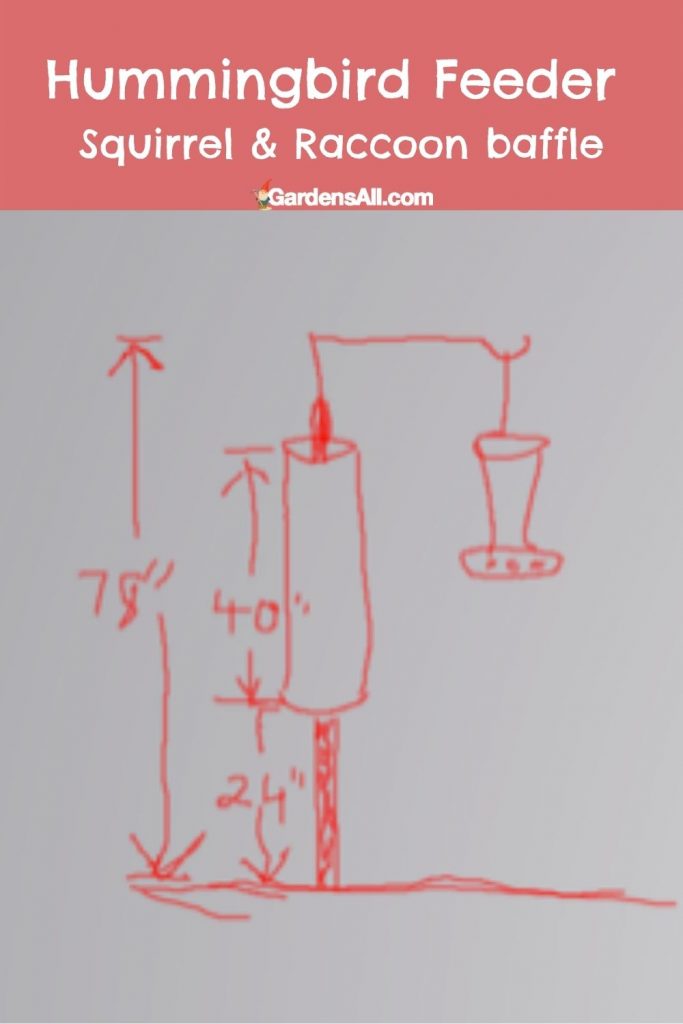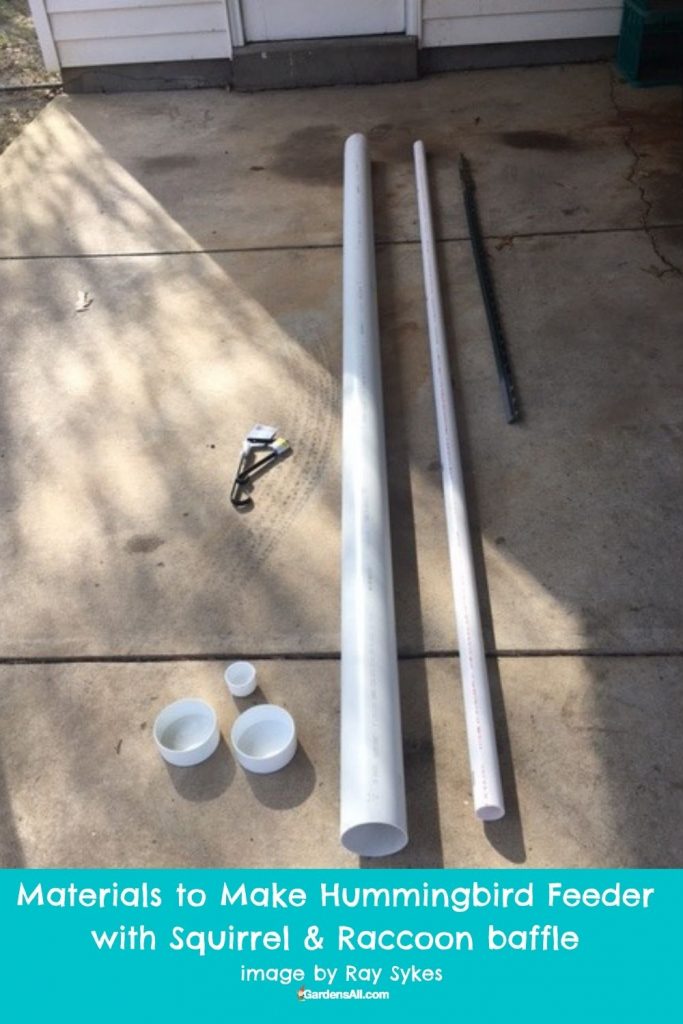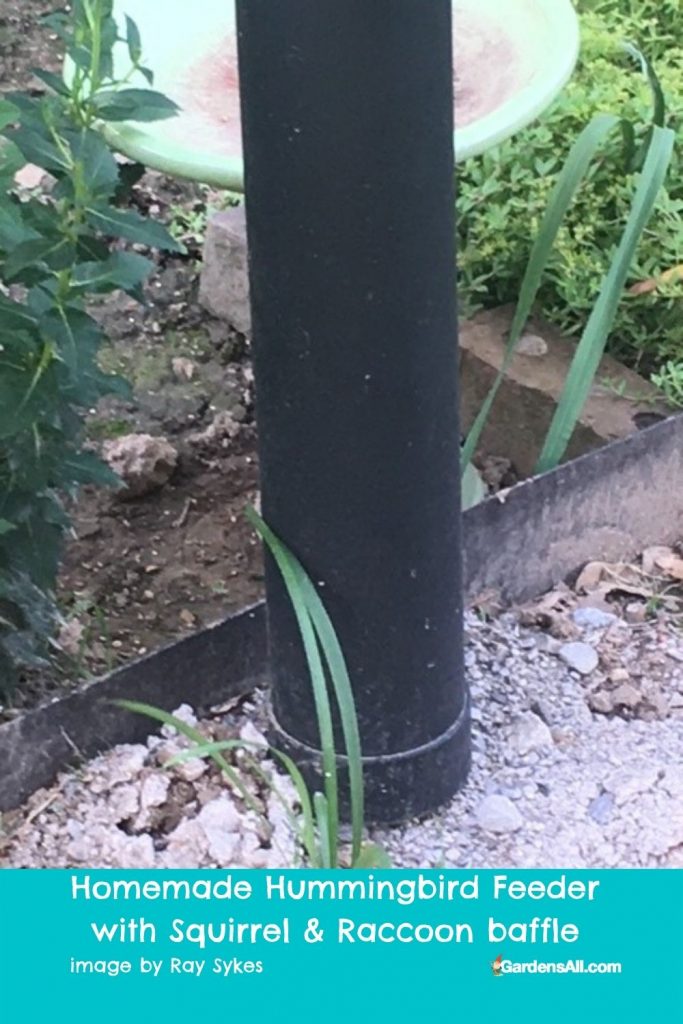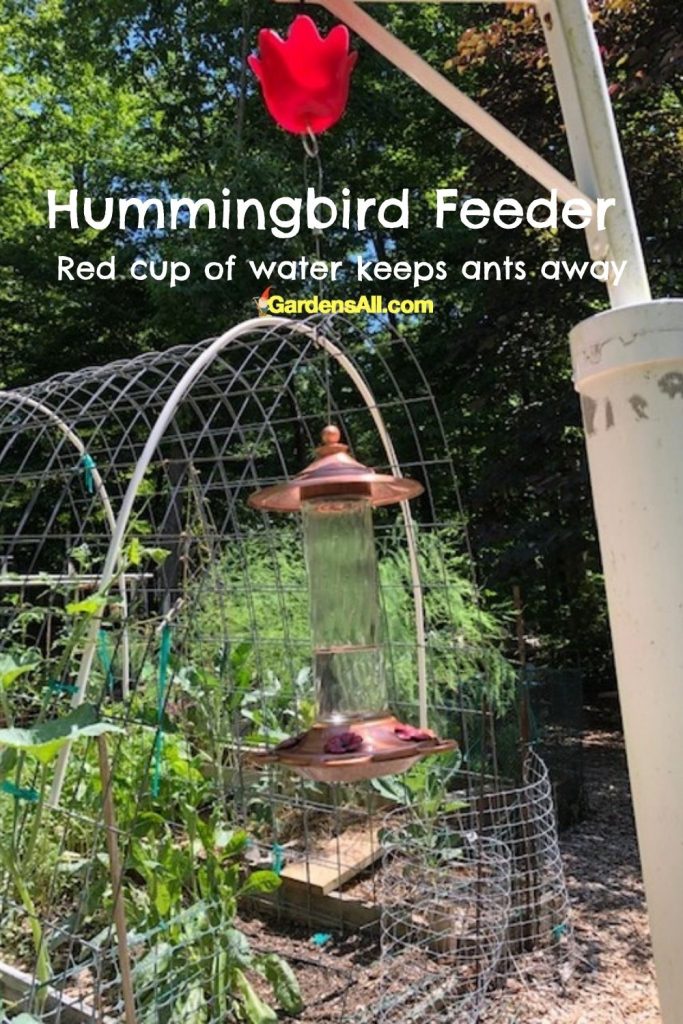We’re always keen to share our favorite garden items, so here we cover what we’ve found to be the best hummingbird feeders.
Last year, we got to know a lot about hummingbirds, hummingbird food, and hummingbird feeders. This year we’ve settled on our favorite feeder out of the three we’ve tried.
Let’s start with a very popular type. Hummers and bird aficionados like this style. But based on our experience, it ranks lowest of the three we’ve tested.
“Pinched Waist” Feeder

Pros
- Red glass vessel
- Wide mouth for easy filling
- Perch at each “flower”
- Least costly
Cons
- Cheaply made
- Puny ant moat
- Bee guards break
- Pain to clean- requires disassembly of fragile parts
- Tends to leak
- AMZN reviews-35% at 3 stars or below-17% one star
“Antique Style” Red Bottle Feeder

We have the original hummingbird feeder we bought last year. Instead of flower like protrusions, the feeding ports are embedded in the top of a tray that screws onto a red glass bottle. Red coated metal flowers are embedded in the top.
Pros
- Looks attractive
- Holds @ 20 ounces
- Red glass (may be slightly more attractive to the birds)
- Fairly easy to clean (just three parts)
Cons
- Narrow bottle opening makes cleaning and filling a challenge
- No ant guard (but you can buy ant guards separately)
- First one we had, one of the “flowers” came off the base. (Returned to store for free replacement)
- Heavier than some of the others
Copper and Clear Glass Feeder
NOTE: We’re no longer using or recommending these. See that update in this article: Reasons to Avoid Metal Hummingbird Feeders.

We took a chance on this 11-ounce copper hummingbird feeder. Both our nectar and the bottle are clear (we’re not fans of red food coloring). Turns out the hummers had no issue finding the feeder and coming to it repeatedly. In fact, it appears to be their favorite. For reasons listed below, it’s our favorite too.
Pros
- Most attractive bottle design, metal top and tray cover
- Easy to see fluid level
- Moderate price (@ $21)
- Very easy to disassemble and clean
- Easy to fill
Cons
- No ant moat
- Bottle holds just 11 ounces (more frequent refills)
- Prone to be more wind blown than heavier feeders
Hummingbird Feeder Review – Copper and Clear Glass Feeder – Video
In this video Coleman discusses our favorite hummingbird feeder amongst the various ones we’ve tried over the past couple years. He also touches on the myth of red food to attract them
While not perfect, the copper feeder wins hands down. The lack of an ant moat can be solved with an inexpensive add-on which may also help lessen the wind effect. And it’s better to have a smaller nectar capacity so that frequent change outs (NOT topping offs!) can occur along with cleaning.
For a full article on hummingbird information, including food recipes and more videos, you may enjoy this article.
DIY Bird Feeder Baffle Thwarts Raccoons and Squirrels
We have a raccoon addicted to the sugar water of the hummingbird food. We have some nighttime video cam footage from last year of it going to all kinds of antics before succeeding at accessing the nectar.
Well, no sooner had we put the feeders out this year and the raccoon started draining them at night. We caught him in the act and posted that video in this Hummingbird Food Recipe article.
Clearly, he remembered it because he was back by the second night the feeders were out. Rather than having to bring them all in at night, I worked up a raccoon baffle. We got footage of him trying it and it worked like a charm. You can see the construction details in this video.
Reader Tries This Bird Feeder Baffle and It Works Great!
We were delighted to hear from GardensAll reader, Ray Sykes. Not only did the bird feeder baffle work well for Ray, he made an improvement by painting his black and by extending it the full length of the pole!


“Hi, I finally finish my bird feeder using your design, decided to run the 4 inch pipe to the ground which is six feet tall. The I ½ inch pipe is 8 ft seven inches tall to accommodate the almost 3 foot tall bird feeder. Read that a squirrel can jump 4 feet so I made the bottom of the feeder 5 feet from the ground. Painted the pole black, going to have a lot of maintenance around the bottom. Thanks again for your help!!”

“Hi, it’s been three months now, I’ve seen no sign of squirrels or raccoons trying to scale the feeder. We have plenty of squirrels, so far there’s no scratch marks along the bottom of the pole. It’s a joy sitting outside sipping coffee while watching the different birds sharing the feeder. Do you have any problems with ants taking over your hummingbird bird feeders, any suggestions?”
“Again thanks for your help!!”
~Ray Sykes
That’s AWESOME!! Great job, Ray, and an improvement on our original. That’s the way! Thanks to Ray for sharing his cool handywork.
When we complimented Ray on his lovely flagstone patio, he said, “Those flagstones are very heavy. After lifting my first stone I went from helper to supervisor.” 🤣
For our answer to Ray’s question about ants, check out the next paragraph.

How to Handle Ants on Hummingbird Feeders
The cure for ants and other crawlies is a little cup that you hang from the feeder hanger and then hang the feeder below. When filled with water the ants have a hard time getting to the feeder because they have to go through the water cup. These are easy to attach above the hummingbird feeders.
Ray made his own ant moat:
Ok I can take some caps from a paint can, drill a hole in the middle of them, run the wire through the hole and put super glue around the wire to hold in the water. This should hold a lot more water.
Thanks for another great ideal!!

G. Coleman Alderson is an entrepreneur, land manager, investor, gardener, and author of the novel, Mountain Whispers: Days Without Sun. Coleman holds an MS from Penn State where his thesis centered on horticulture, park planning, design, and maintenance. He’s a member of the Phi Kappa Phi Honor Society and a licensed building contractor for 27 years. “But nothing surpasses my 40 years of lessons from the field and garden. And in the garden, as in life, it’s always interesting because those lessons never end!” Coleman Alderson

